Reference no: EM132272518
PART A
1) Introduction to Business Process Management
Compare the two improvement movements of business process reengineering (BPR) and the more modern approach of business process management (BPM) by answering the following questions in a short essay of around 500-800 words:
a) Describe the benefits and shortcomings of BPM vs BPR?
b) Explain which phase of the BPM life cycle does BPR discard entirely and why that particular phase is not necessary in BPR?
c) Explore and describe ways of how BPR and BPM could be combined in a company's long-term continuous improvement methodology?
Hint: Focus on stating facts backed up by evidence, rather than superficial descriptions.
2) Foundations of BPMN
Create a 2 column table stating the exercise number in one column and your answer letter in the other column:
2.1 How would you connect 2 BPMN pools with each other and how would you connect elements within one of these pools?
A) A start event and an event-based decision element
B) Message flows and sequence flows
C) 2 data objects and message flows
D) Sequence flows and message flows
2.2 Which connection elements in the following BPD are associations
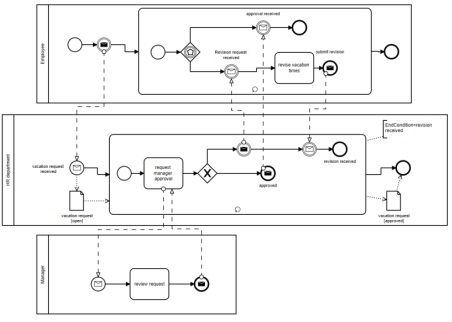
A) There are no associations
B) The connection element going into and out of the open as well as the approved vacation request
C) The two connection from the request manager approval activity to the start and end event in the manager pool
D) All the connections between the HR department and the Employee
E) The two little circle arrows
2.3 Assume for the following BPD that all start events are triggered at once (i.e. they all get a token). How many times will D be executed before the process ends?
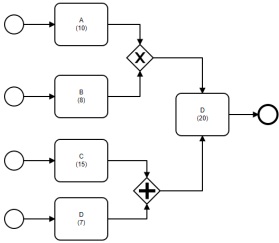
A) 1 time
B) 2 times
C) 3 times
D) 4 times
E) 0 times, the process model is wrong
2.4 Which BPMN element would normally be used to represent entities from a hierarchical organisational chart?
A) The sequence flow connecter
B) An annotation stating the organisational entity
C) The Pool and Lane elements
D) Activities with the label same label as the organisational chart element
E) This cannot be done in BPMN, UML models must be used for this.
2.5 What kind of BPMN construct is used to reverse, restore or counter a previous activity?
A) Offset
B) Reciprocal
C) Transaction
D) Compensation
E) Complex gateways
2.6 What are the only elements which can be connected after this element?

A) Any BPMN element
B) Any intermediate events
C) This is a UML element and not part of BPMN
D) Receiving Message, Timer, Condition, Signal Events and Message receiving tasks
E) Only message throwing events and tasks
2.7 A BPD usually represents which three of the following symbol categories
A) Swimlanes
B) Flow Objects
C) Vision and Mission elements
D) Connecting objects
E) Class Diagrams
F) Fishbone diagrams
2.8 Which of the following phases are NOT part of the Business process Life cycle?
A) Process Identification
B) Process Duplication
C) Process Elimination
D) Process Discovery
E) Process Monitoring
F) Process Mirroring
G) Process Colouring
2.9 What is the purpose of modeling a hierarchy in Business processes?
A) to model the processes used to accomplish an organization's goals
B) to present the hierarchy of the information processed by an organization
C) to represent composition and decomposition of processes in a hierarchical manner
D) to depict the hierarchy of interactions that occur between different business processes
2.10 A subprocess must fulfil two conditions. These are (select 2)
A) It makes up part of the overall business process
B) It is the lowest level of child sub-processes of a parent process
C) It has at least one parent process and cannot be further decomposed into sub- processes
D) It breaks down the parent process into one or more child business process diagrams that contain other low-level sub-processes or tasks.
2.11 How many times will the subprocess loop for until complete if the generated number happens to be 300?
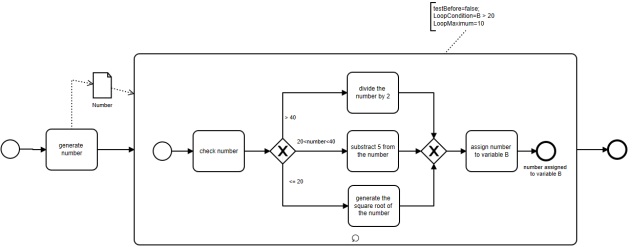
A) It will not loop at all
B) 5 times
C) 9 times
D) 7 times
E) 10 times
2.12 How many work orders will be created by the subprocess "create work orders", if a customer purchase order with 20 items listed is received?
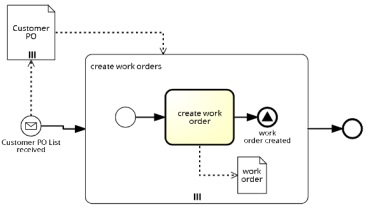
A) 1 work order
B) 2 work orders
C) 20 work orders
D) 100 work orders
E) It will loop indefinitely because there is no loop maximum defined.
2.13 If a process token reaches a terminate end event, it...
A) triggers a collapse of all the subprocesses below the current level only
B) stops all the parent processes but not itself
C) it waits for all the subprocesses to finish normally but cancels the process at its current level
D) stops the entire process at the same level as well as all subprocesses
2.14 If the non-interrupting timer boundary event attached to the activity "review admissions" is triggered, it means that
A) stop reviewing admissions and perform the activity downstream from the timer event
B) send a timestamp signal to the process engine to stop the process
C) perform the activity downstream from the timer event without interrupting the review activity
D) restart the review task because the time ran out
3) Intermediate BPMN
3.1 Explain in detail the following BPD textually. What does it do, when would it start and how long could it run for? Where would one expect to find such a process description?
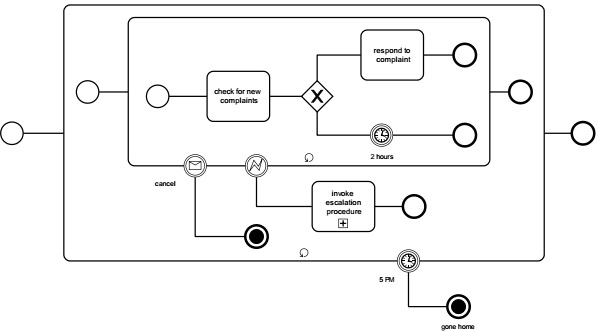
3.2 Review the business process model in figure A on page 6. In its current form it contains various modeling errors:
1) Find at least 15 mistakes and highlight them.
2) Explain in tabular form why the identified "mistake" is a mistake using the rules of BPMN and/or the BPMN 2.0 Specification.
3) Correct the identified mistakes in a new BPMN model
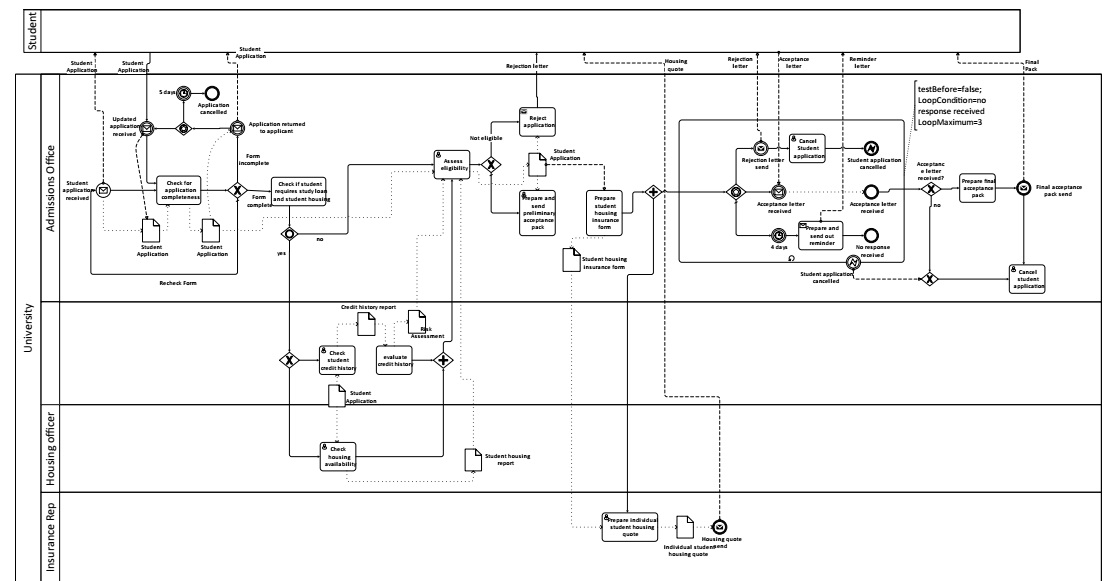
Figure A: BPMN Model with mistakes
3.3 Transform each of the following process descriptions into BPMN Diagrams modeled from the company perspective.
A) At the receipt of a customer complaint, the customer service agent verifies if the complaint information (such as original invoice, description of the failure report, serial number etc.) sent by the customer is complete in the customer relationship management module (CRM). If the information is incomplete, the customer service agent requests the missing information. If the customer has still not sent the necessary information, the complaint is declined by the customer service agent. In the other cases, the customer service agent holds enough information to process the complaint.
B) Sue, who has been unemployed for 2 years now, decides to send out applications to multiple companies in her city which offer suitable job positions. At one of the companies she applied to, once the application has been received, it will be checked for completeness.
In case the application is erroneous, a request for further documents would be send out to Sue. Sue would then be given 7 workdays to resubmit her documentation. Once here resubmitted documents have been received, they be checked for completeness again and go through the same steps again. If no documents have been received after the 7 days, the company would try to call Sue to enquire if she still would like to apply for the job. If that is the case, she would be given another 7 days before she would receive another phone call. If Sue withdraws her application in one of the phone calls, the company would then return her application pack to her and the process ends.
In case the application is complete, the company would evaluate Sues suitability for the job position. If the company thinks the job would not fit Sue, they will return her job application pack to her. If the evaluation is positive on the other hand, her evaluation will be added to the list of possible applications. They will receive in invite in a different process.
3.4 Calculate a competitive offer for the following process project proposal:
While working as the managing process analyst (MA) at Crazy Process Rookies - Consulting (CPR- Consulting) and leading your small team of process analysts you receive a different RFP (request for proposal):
The team has grown from when you first started to 4 lead analysts (LA) and 8 consultant analysts (CA) as well as 2 young analysts (YA). The lead analysts are more experienced and well-educated in all parts of the process analysis life cycle. All have between 5-8 years BPM Experience. The consultant analysts are established, comfortable in process analysis and workshops with 2-5 years of experience. Young analysts are straight out of university, usually with a bachelor's degree. They have very little client site experience. You yourself have been in the BPM game for more than 10 years and you know all the ins and outs. The internal charge rates (ICR) for the different consultant levels are as follows: MA - 180AUD/h; LA - 160AUD/h; CA - 100AUD/hour; YA - 80 AUD/hour. CPR
Consulting charges their client's different external day rate for these experience levels. They are 1500 AUD for MA, 1300AUD for LA, 1000AUD for CA and lastly 900AUD for the young analysis.
One day, you receive a phone call from Runnings in the Joondalup asking for an RFP for a process documentation project. Runnings specialises in sportswear.
The RFP document explains, that there is a need to have 26 processes mapped out in 5 different departments:
• 6 processes are in Department A
• 8 Processes are in Department B
• 4 Processes are in Department C
• 6 Processes are in Department D
• 2 processes are in Department E
Department E is a sub-department of department D, meaning that some people from Department D also manage and run the 2 processes in department E during their work hours. Employees have said that their team cannot discuss department D's and E's processes at the same time or the will run into time management problems incurring fines. There an no other interdependencies between departments.
All the processes in department A and C considered medium complexity as people have attempted to document them in excel forms and other simple flow chart notations. Department B's processes are the core processes of the company and highly specialised. Therefore, they are categorised as very high complexity. The processes in department D and E are short and therefore considered as simple and low complexity.
Simple processes involve around 10 main activities with 2 roles, medium complexity processes are assumed to have around 15-20 activities operated by 4-6 roles. Information to these workflows is known to be kept in various word documents, excel sheets, non-standardised flowcharts and as intangible knowledge. Complex processes, on the other hand can have 25-30 main activities executed by 6-9 roles. Documentation about their core processes is likely to be outdated.
Process Owner X is responsible and accountable for processes in Departments A, B and C while process owner Y is responsible and accountable for processes in Department D and E. Process Owners have the authority to approve validated and verified process models.
The scope of the project is to create the 26 AS-IS processes, have them quality assured and lastly published in their internal Business Process Repository and announced through the internal notification system, so that every staff member can access it. Project start is set to be May 1st, 2019 and Runnings wants this project to be completed within 3 months.
The offer must be a fixed (all-in) price offer. Runnings always expects high quality work from their partners. In return, their employees are young and eager to discover their processes as they see the benefits of process management and will accept proposed meeting invites straight away.
Your Client Manager at CPR expects a project margin of at least 28% from this project, otherwise you have to justify your deviation from it. Luckily for you, you overheard a conversation of your long-time competitor ‘Rapid Process Management' during the council project talking about this Runnings project. Their Project Manager mentioned their offer will be around 450'000AUD all in.
The standard working week in Australia is 38 hours per week (7.6 hours per day), usually worked Monday to Friday. Work beyond that amount is overtime and attracts a premium (Treat Public Holidays as normal work days if they fall on a weekday).
A) What is your project sales price, internal project cost and project revenue?
B) What is your project team size?
C) What is your project duration?
Include a screenshot of your project calculation as well.
PART B
4) Advanced BPMN/BPM Lifecycle
Scenario 4.A
We consider the following process performed by an IT helpdesk that handles requests from clients. The clients are employees of a company. There are about 1000 employees in total. In general, a request may be an IT-related problem that a client has, or an access request (e.g. requesting rights to access an IT system). Requests need to be handled according to their type and their priority. There are three priority levels: "critical", "urgent" or "normal". The current process works as follows:
A client calls the help desk or sends an e-mail in order to make a request. The help desk is staffed with five "Level-1" support staff who typically are junior people with less than 1 months experience but can resolve known problems and simple requests. The hourly cost of a Level-1 staff member is AUD 40.
When the Level-1 employee does not know the resolution to a request, the request is forwarded to a more experienced "Level- " support staff. There are three Level-2 staff members and their hourly cost is AUD 60. When a Level-2 employee receives a request, she evaluates it and assigns it a priority level. The job tracking system will later assign the request to the same or another Level-2 staff depending on the assigned priority level and the backlog of requests.
Once the request is assigned to a Level-2 staff member, the request is researched by the Level-2 employee and a resolution is developed and sent back to the Level-1 employee. Eventually, the Level-1 employee forwards the resolution to the client who tests the resolution. The client notifies the outcome of the test to the Level-1 employee via e-mail. If the client states that the request is fixed, it is marked as complete and the process ends. If the request is not fixed, it is resent to Level-2 support for further action and goes through the process again.
Requests are registered in a job tracking system. The job tracking system allows help desk employees to record the details of the request, the priority level and the name of the client who generated the request. When a request is registered, it is marked as "open". When it is moved to level , it is marked as "forwarded to level " and when the resolution is sent back to "Level 1' the request is marked as "returned to level 1". Finally, when a request is resolved, it is marked as "closed". Every request has a unique identifier. When a request is registered, the job tracking system sends an email to the client straight away. The e-mail includes a "request reference number" that the client needs to quote when asking questions about the request.
The helpdesk receives approximately 50 new requests per working day. The current process is known to be error-prone. The most frequent types of errors include:
• Many requests take too long to be processed. Clients need to call often to remind the helpdesk that their requests are still unresolved
• When the client asks what the status of a is given request, oftentimes the helpdesk gives an incorrect answer. In other words, the Level-1 helpdesk staff are unable to accurately determine what is the status of every request.
• When reviewing the list of open requests, the Level-1 staff often find many requests marked as "open", but these requests are in fact already resolved.
You as the lead process analyst decide to collect quantitative process data. The insights you gained are as follows:
• Submitting and registering a new request takes 5 minutes on average.
• Requests spend on average 1 hour waiting for a Level-1 staff to check them. This applies both to new requests and to re-submitted requests.
• Checking if a new request is "known" takes on average 10 minutes. In 0% of cases the request is known. In this case, it takes about 5 minutes for the Level-1 staff to communicate the resolution to the client. Once this is done, the request is marked as "closed". On the other hand, if the request is not "known", the request is automatically forwarded to Level 2.
• New requests spend on average 2 hours waiting for a Level-2 staff to evaluate them. Level-2 staff take on average 20 minutes to evaluate a new request.
• Level-2 staff take 5 minutes to prioritize a request.
• The time between the moment a request has been prioritized, and the moment the request is picked-up by a Level-2 staff member is 20 hours.
• The time required to research and resolve a request is on average 2 hours. The time to write the resolution to a request is on average of 20 minutes.
• Once a Level-2 staff has written the resolution of a request, it takes on average 20 hours before the request is fetched from the job tracking system by a Level-1 staff.
• It takes on average 20 minutes for a Level-1 staff to send to the client a problem resolution previously written by a Level-2 staff.
• It takes on average 20 hours between the moment a resolution is sent by the Level-1 staff, and the moment the resolution is tested by the client.
• It takes the client around 10 minutes to e-mail the test results to the Level-1 staff.
• In 20% of cases the request is not resolved, and it needs to be forwarded to Level-2 again. In this latter case, it takes about 2 minutes for the Level-1 to forward the request to the Level-2 staff. Unresolved requests that are forwarded in this way are automatically marked as "prioritised" since they have already been prioritised in the previous iteration.
Task 4.A.1) Model the above "as is" process in BPMN. Your process should show a high level of detail with respect to who executes what activity and different states of business objects flowing through the process. Make use of subprocesses where appropriate.
Task 4.A.2) Classify the activities in this process into three categories: "value adding" (VA), business value-adding (BVA) and non-value-adding (NVA) in a simple table.
Task 4.A.3) Calculate the cycle time efficiency of the "as is" process
Task 4.A.4) Calculate the average number of requests in the process at any given time [Hint: It's Little].
Task 4.A.5) Identify the main constraint in the process. Explain how you arrived at that decision (you may refer to textbook 7.1.4 & 7.1.5 for extra points if proven mathematically). Propose 3 changes to elevate that constraint.
Task 4.A.6)
Write an issue register for the process with at least 6 issues, including the main constraint identified in the previous task. Prioritise your issues from a TOC perspective.
Task 4.A.7) Develop a "to-be" BPMN model that incorporates your proposed changes.
Scenario 4.B
ABC Insurance is in the process of reviewing its corporate processes. They decide that they will investigate their existing claims handling and fulfilment process for windscreen repairs. They plan to complete an as-is model and an initial improved to-be model to address existing issues with the claim process. The to-be model will incorporate use of the Internet and Call centres to address existing problems.
The auto windshield claims value chain can be viewed as including three subprocesses: handling the reporting of the claim (which includes checking insurance coverage to see if the customer is insured); repairing the windshield; and processing the insurance claim and settling payment. Apart from ABC Insurance and the insured customer, the other partners in the process include independent insurance agents who sell ABC Insurance policies and glass repair shops that repair windshields.
There are several inefficiencies and customer service problems in the current windshield repair claims process at ABC Insurance. When an insured customer needs to have their windshield repaired, the insured usually calls his independent insurance agent or ABC Insurance to inquire where to take their vehicle to have the repairs conducted. In many cases, the insured person encounters various delays in reaching the agent or ABC Insurance due to the backlog of phone calls at these locations. When the insured does get through, the agent or ABC Insurance checks that his claim is valid, at which point the insured is directed to take his vehicle to a choice of repair shops.
The current process has some unwanted fraud exposure. If the insured is told by ABC Insurance that they do not have windshield coverage, there is nothing to stop them from phoning their agent and requesting to have the coverage added to their existing policy and then claiming for the windshield later.
Once the insured is at the glass repair shop, the repair shop has to call either the agent or ABC Insurance to confirm the insurance coverage and any applicable deductible from the total payment. The repair shop then encounters the same telephone delay problems in phoning the agent or ABC Insurance. In some cases, the repair shop may not be able to get through to the agent or ABC Insurance until after hours or a weekend, and so the shop may proceed with the repairs without authorization. In these instances, the repair shop assumes the risk if the insured does not have the proper insurance coverage and/or payment deductibles. If this occurs, the repair shop often spends much effort getting the customer to pay the money they owe. The repair shop usually takes the financial risks instead of losing the customer to a competitor.
If the insurance coverage and deductible are confirmed, the insured customer pays the glass repair shop the balance less any deductible and the repair shop forwards the invoice for the remainder (usually in hard copy format) to ABC Insurance.
Upon receipt of the paper invoice, ABC Insurance begins processing the claim. The invoice is scrutinized to ensure that appropriate pricing and discounts have been applied. If not, the invoice will be amended to reflect these changes. If the claim is not valid (no coverage), the invoice will be sent back to the glass repair shop indicating the reason for denial. If the claim is valid, the invoice information will be entered into ABC Insurance's claim processing computer application system and the claim will be processed. The payment is made either in a bulk check or individual check depending upon the payment agreement. The payment is mailed, and claim notices are generated and mailed to the agent. Upon receipt of the claim notice, the agent will update his or her computer system with the claim information.
Task 4.B.1: Model a Process Architecture using a Value chain diagram. The Level 0 should show management, core and support processes. Derive some management and support processes from the scenario. They need to be relevant to the case.
Task 4.B.2: Extend your Value chain diagram by modeling the "AS-IS" process using BPMN to highlight the major activities and responsibilities within the existing windscreen repair system. You may have to model more than one BPD to fit into the architecture. Your process model must show a high level of detail, i.e. Pools/Lanes, Control Flow and flow objects.
Task 4.B.3: The existing process has several "pain points". Identify and analyse these problems by:
a) Creating an Issue register for the process. Identify at least 5 issues.
b) Choose the issue with the highest priority in your list and create a Fishbone diagram to investigate different causes for the process.
c) Go over the identified causes of your fishbone, identify their impact relevance for the process. Highlight/Circle the relevant causes in your As-Is model.
Task 4.B.4: Develop the To-Be Model:
a) Choose and state a suitable improvement direction (axis of the devil's triangle) using your task 4.B.3 findings as input
b) Identify suitable improvement heuristics for the identified process areas based on your improvement direction and model the To-Be process.